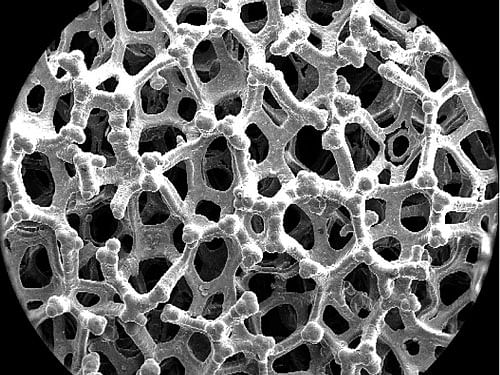
Scientists have constantly been exploring ways to harness graphene’s unique properties. One such result was the graphene foam — a microscopic, three-dimensional network, writes Debadrita Paria
Every morning, the toothpaste foam makes your teeth germ free. The foam from your shampoo keeps your hair clean and that foam from your detergent washes away all the dirt off your soiled clothes.
Now, how about a different kind of foam that protects your mobile phone from accidental drop or better still protects you from harmful gases? Known as ‘graphene foam’ in the world of nanotechnology, this kind of foam is quite different from what we usually encounter in our everyday lives.
Graphene is a single layer of graphite, a material found in a pencil lead. When carbon atoms are arranged in a hexagonal pattern in a two-dimensional plane, graphene is formed. It has many exotic, mechanical, thermal, electrical and chemical properties that are very unique. It is 300 times harder than steel, stronger than diamond, can carry current with almost zero resistance and transfer heat very fast.
The Nobel Prize in Physics was given to two scientists Andre Geim and Konstantin Novoselov from the University of Manchester in 2010 “for groundbreaking experiments regarding the two-dimensional material, graphene.”
Over the past several years, scientists have explored several ways of harnessing graphene’s unique properties. One such use is converting graphene into a microscopic three-dimensional network known as graphene foam. Graphene foam has exceptional load bearing capacity and thus, it can be used to protect electronic devices like mobile phones and laptops from accidental damage. Since it has a very large surface area, it can absorb harmful gases and act as a sensor or store energy and act as a tiny battery. People have even shown its application as a biological culture medium.
Shock absorber for mobile phones
A young and dynamic team at the Indian Institute of Science (IISc), Bengaluru have made some groundbreaking progress in exploring important applications of graphene foam. They have designed a miniature shock absorber that can easily fit inside our ultra-thin smart phones or laptops.
“Graphene was made into three-dimensional network structure known as graphene foam, a light-weight foam that is akin to a sponge. Composed of an extremely thin layer of graphene, its density is only 0.54 grams per cubic cm, as compared to 7.87 and 2.7 gram per cubic cm of iron and aluminium respectively,” says Abha Mishra, assistant professor, Department of Applied Physics, who led the research team. Apart from being small in size, the graphene foam based shock absorber can be subjected to several cycles of operation unlike conventional metal based shock absorbers, which breakdown after a single operation.
Nitrogen dioxide is one of the main causes of air pollution. Excessive level of nitrogen dioxide in the atmosphere causes acid rain. When inhaled in large quantity, it leads to decreased lung function and various respiratory diseases in humans. Measuring the amount of nitrogen dioxide in the atmosphere can help in keeping air pollution in check. The research team at IISc has successfully demonstrated a nitrogen dioxide sensor using graphene foam.
“The graphene-based sensors work on the principle that charge transfer takes place between graphene foams and adsorbed gas molecules. This changes the resistance of the foams and hence their electrical conductivity (how easily current can flow). By measuring these changes in electrical conductivity, it can be easily correlated with the levels of ambient nitrogen dioxide,” said Abha explaining their research. Their method is a lot more sensitive to low concentrations compared to the other well-established ones and has managed to set up new standards for nitrogen dioxide detection.
High-speed photodetector
Another interesting application of graphene foam is a high-speed photodetector. A photodetector is a sensor that can sense light. We come across photodetectors in numerous places — like in a simple TV remote, automatic opening of doors in malls to cameras and Carbonate Compensation Depths. They are also used in light-based communication, and for detecting energy from outer space.
The team has fabricated a low cost photodetector, which detects ultraviolet (UV) light commonly found in the sunray. This was done by integrating zinc oxide (a semiconducting material similar to Silicon) with graphene foam. “In our case, the UV photodetector is simple, less expensive and has high photodetection speed with visible blind UV illumination,” says Abha. Commercial photodetectors cannot selectively detect ultraviolet light.
Moreover, they are expensive and have very slow response. The proposed device addresses all these issues. “These ultralight and highly sensitive three-dimensional structures can essentially pave the way for highly efficient sensing systems,” exclaims Abha.
Though research with graphene foam is relatively new, it has a great potential of expansion as it promises novel, miniature devices with better capabilities to solve several everyday problems. So, next time you ‘foam up’ early morning you might think about graphene foam taking a place in your every day schedule!
(The author is with Gubbi Labs, a research collective based in Bengaluru)